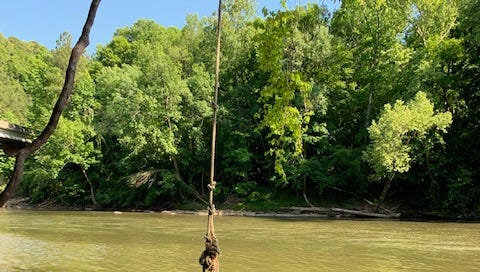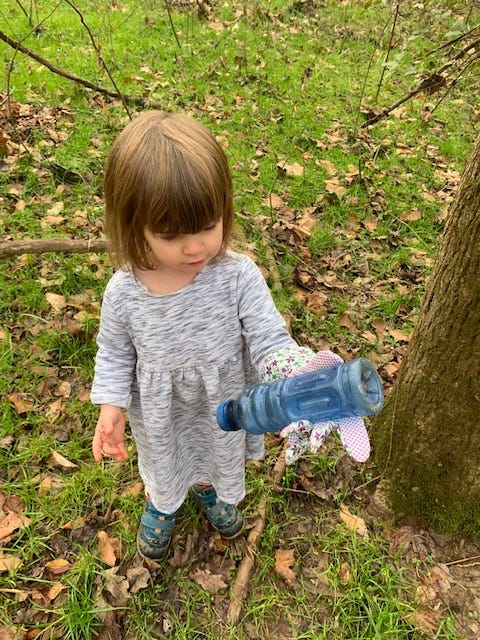The other day, after school and work, Bea and invited our friend Krista to raft the Haw. Krista met us at the kayak launch, where we used our foot pump to inflate two big rafts, and then we carried them to the easement we share with our neighbors.
It was almost ninety degrees, and by the time we made it to the riverbank we were tired. We sat down for a minute to rest (“can’t we get in the water now?” Bea wanted to know), and Krista told me about the meditation group she’s been part of for the past year. They meet online, but she says the experience is surprisingly moving, even transformative. She says that one of their goals has been to pay attention to the body, the breath—all that focused, patient attention-giving that I’m not very good at in yoga or meditation. Over time, she says she’s noticed that she feels things in parts of her body she never paid attention to before. Now the group is moving their attention to the idea of numbness, the parts of the body and mind that still aren’t engaged, and connecting that to social justice and making change in the world.
“Isn’t that the challenge of life?” she asked, just before we slid down the muddy banks to the water. “Overcoming our numbness, all the terrible things we ignore, just because they’re not right in front of us?”
Bea jumped on the raft, and I jumped on after her. We spun in the current, and I let my feet trail in the perfectly cool water. We dipped under some low-hanging branches, then zoomed down a rapid. We snagged against a rock, and Bea jumped off and freed us.
“I’m the captain!” Bea likes to say from her perch on the raft. She directs us when she wants to stop and swim, and I warn her, don’t put your head under the water, don’t open your mouth. Mostly, she obeys. I remember the PFAS in the water because I want to protect her from their many dangers, but I think without her there I would easily forget about them.
The river is so lovely, so full of wildlife, that it’s hard to see it as endangered. As you make your way down the current, sometimes the raft spins you backwards and you can see the way the elevation is declining—it’s like descending a very gradual staircase of ancient rocks, coursing with water. The water is shallow, and when you haven’t had much rain—as we haven’t, lately—it’s very clear. You can see to the bottom: rocks, mussels, moss, sand, small fish. There are turtles and snakes and herons. We saw a bald eagle, as we almost always do.
It looks so clean! But we know it isn’t. In fact, just before Krista arrived Bea and I spoke to a woman who was headed to the kayak launch with a complicated-looking apparatus—a tool, she told us, for measuring E.coli pollution caused by careless farming practices and factory runoff. “It’s pretty good at this spot,” she assured us. “71%. Better than upriver.”
What does 71% mean? I wondered at the end of our trip, as Krista and I deflated the rafts while Bea did tricks on the rope swing. 71% clean? 71% free of E.coli? That doesn’t seem… sufficient.
“Are you sure I can’t swim underwater?” Bea asked. “Just for a second?”
I told her no, and no again.
I’m bad at meditation, but trying to get better at paying attention to the places where it’s easy to be numb—unseen pollution, the heat waves and damaging hurricane and fire season that isn’t here yet, the fact that climate change and poor air and water quality are already disproportionately harming poor people and people of color. Filtering that knowledge to a child who wants to see the world as it presents itself—sparkling in late-May sunshine—is tricky.
I take comfort in the Biden administrations actions on PFAS, and especially the leadership of Michael Regan, our new head of the EPA, who has spent a lot of his career fighting PFAS pollution of rivers in North Carolina, his home state. Regan is the first Black man and the second person of color to lead the EPA; he is also the first to graduate from a Historically Black College and University, North Carolina Agricultural and Technical State University. Only forty-four, and the parent of a young child. It feels good to have him looking out for us.
I also feel better when we’re pitching in. Sometimes we pick up trash along the riverbank; the girls wear gloves and argue over whose turn it is to grab the next piece of garbage. Even if they have nothing to do with PFAS, these small acts put us in touch with nature’s problems, as well as her beauty.
I made a mental note to contact the Haw River Assembly about volunteering with Bea, who jumped (literally) at the idea. “The river is very important to me,” she said. Even (especially?) if she can’t put her face in the water.
More soon on what we come up with, as river volunteers (thank you to Louise for the suggestion!). Look for a kid post on moth science on Tuesday!
Anyone hearing (seeing? Crunching?) the Brood X cicadas? We would love to hear about it.
Why did the frog eat the firefly?
It wanted a light snack.





